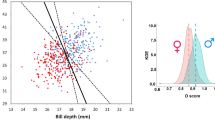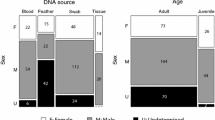Abstract
The current paper examines the accuracy of existing binary logistic regression equations for sex prediction based on pelvic and cranial traits in a modern Greek assemblage and proposes new equations with the aim of improving correct classification rates for Balkan material. Our results suggest that existing equations based on pelvic traits perform very well on the Greek material, which can be attributed to the fact that sexual dimorphism in the pelvis results from common evolutionary forces across populations. In contrast, equations based on cranial traits are highly dependent upon the populations based on which they were developed, stressing the need to produce more population-specific functions. Our proposed equations achieve correct sex classification in 92.59% of the females and 95.79% of the males for pelvic traits, while these percentages rise to 97.53% for females and 98.95% for males when the vertical femoral head diameter is included in the models. Our functions based on cranial traits produced correct classifications in up to 92.59% of females and 88.42% of males, and when the cranial scores where combined with the vertical femoral head diameter, the correct classification rates increased to 93.83% for females and 94.73% for males. Prior to the generalization of the use of these functions, further research examining their accuracy in other groups is required, but our results appear promising.
Similar content being viewed by others
References
Alunni-Perret V, du Jardin P, Nogueira L, Buchet L, Quatrehomme G (2015) Comparing discriminant analysis and neural network for the determination of sex using femur head measurements. Forensic Sci Int 253:81–87. doi:10.1016/j.forsciint.2015.05.023
Bidmos MA, Steinberg N, Kuykendall KL (2005) Patella measurements of South African whites as sex assessors. Homo 56:69–74. doi:10.1016/j.jchb.2004.10.002
Clavero A, Salicrú M, Turbón D (2015) Sex prediction from the femur and hip bone using a sample of CT images from a Spanish population. Int J Legal Med 129:373–383. doi:10.1007/s00414-014-1069-y
Spradley MK, Jantz RL (2011) Sex estimation in forensic anthropology: skull versus postcranial elements. J Forensic Sci 56:289–296. doi:10.1111/j.1556-4029.2010.01635.x
Sulzmann CE, Buckberry JL, Pastor RF (2008) The utility of carpals for sex assessment: a preliminary study. Am J Phys Anthropol 135:252–262. doi:10.1002/ajpa.20738
Bigoni L, Velemínská J, Brůzek J (2010) Three-dimensional geometric morphometric analysis of cranio-facial sexual dimorphism in a Central European sample of known sex. Homo 61:16–32. doi:10.1016/j.jchb.2009.09.004
Bytheway JA, Ross AH (2010) A geometric morphometric approach to sex determination of the human adult os coxa. J Forensic Sci 55:859–864. doi: 10.1111/j.1556-4029.2010.01374.x
Chovalopoulou ME, Valakos ED, Manolis SK (2016) Sex determination by three-dimensional geometric morphometrics of craniofacial form. Anthropol Anz J Biol Clin Anthropol 73:195–206. doi:10.1127/anthranz/2016/0470
Gómez-Valdés JA, Quinto- Sánchez M, Garmendia AM, Veleminska J, Sánchez-Mejorada G, Brukel J (2012) Comparison of methods to determine sex by evaluating the greater sciatic notch: visual, angular and geometric morphometrics. Forensic Sci Int 221:156.e1–7. doi: 10.1016/j.forsciint.2012.04.027
Gonzalez PN, Bernal V, Perez SI (2009) Geometric morphometric approach to sex estimation of human pelvis. Forensic Sci Int 189:68–74. doi:10.1016/j.forsciint.2009.04.012
Green H, Curnoe D (2009) Sexual dimorphism in Southeast Asian crania: a geometric morphometric approach. Homo 60:517–534. doi:10.1016/j.jchb.2009.09.001
Rosas A, Bastir M (2002) Thin-plate spline analysis of allometry and sexual dimorphism in human craniofacial complex. Am J Phys Anthropol 117:236–245. doi:10.1002/ajpa.10023
Huseynov A, Zollikofer CPE, Coudyzer W, Gascho D, Kellenberger C, Hinzpeter R, Ponce de León MS (2016) Developmental evidence for obstetric adaptation of the human female pelvis. P Natl Acad Sci 113:5227–5232. doi:10.1073/pnas.1517085113
Buikstra JE, Ubelaker DH (1994) Standards for data collection from human skeletal remains. Fayetteville, Arkansas Archeological Survey Research Series No 44
Walker PL (2008) Sexing skulls using discriminant function analysis of visually assessed traits. Am J Phys Anthropol 136:39–50. doi:10.1002/ajpa.20776
Klales AR, Ousley SD, Vollner JM (2012) A revised method of sexing the human innominate using Phenice’s nonmetric traits and statistical methods. Am J Phys Anthropol 149:104–114. doi:10.1002/ajpa.22102
Phenice TW (1969) A newly developed visual method of sexing the os pubis. Am J Phys Anthropol 30:297–301. doi:10.1002/ajpa.1330300214
Konigsberg LW, Algee-Hewitt BFB, Wolfe Steadman D (2009) Estimation and evidence in forensic anthropology: sex and race. Am J Phys Anthropol 139:77–90. doi:10.1002/ajpa.20934
Eliopoulos C, Lagia A, Manolis S (2007) A modern, documented human skeletal collection from Greece. Homo 58:221–228. doi:10.1016/j.jchb.2006.10.003
Auerbach BM, Ruff CB (2004) Human body mass estimation: a comparison of “morphometric” and “mechanical” methods. Am J Phys Anthropol 125:331–342. doi:10.1002/ajpa.20032
Cohen J (1968) Weighted kappa: nominal scale agreement with provision for scaled disagreement or partial credit. Psychol Bull 70:213–220
Soficaru A, Constantinescu M, Culea M, Ionică C (2014) Evaluation of discriminant functions for sexing skulls from visually assessed traits applied in the Rainer Osteological Collection (Bucharest, Romania). Homo 65:464–475. doi:10.1016/j.jchb.2014.08.004
Gómez-Valdés JA, Menéndez Garmendia A, García-Barzola L, Sánchez-Mejorada G, Karam C, Baraybar JP, Klales A (In press) Recalibration of the Klales et al. (2012) Method of sexing the human innominate for Mexican populations. Am J Phys Anthropol doi: 10.1002/ajpa.23157
Kenyhercz MW (2012) Sex estimation using pubic bone morphology in a modern South African sample: a test of the Klales et al. method. Poster presentation in the 81st Annual Meeting of the American Association of Physical Anthropologists, Portland, Oregon
Klales AR, Cole SJ (In press) Improving nonmetric sex classification for Hispanic individuals. J Forensic Sci doi: 10.1111/1556-4029.13391
Klales A, Kenyhercz M, Stull K, McCormick K, Call S (2016) Worldwide population variation in pelvic sexual dimorphism. Poster presentation in the 85th Annual Meeting of the American Association of Physical Anthropologists, Atlanta, Georgia
Krüger GC, L’Abbé EN, Stull KE, Kenyhercz MW (2015) Sexual dimorphism in cranial morphology among modern South Africans. Int J Legal Med 129:869–875. doi:10.1007/s00414-014-1111-0
Gruss LT, Schmitt D (2015) The evolution of the human pelvis: changing adaptations to bipedalism, obstetrics and thermoregulation. Philos Trans R Soc Lond Ser B Biol Sci 370(1663): 20140063. doi: 10.1098/rstb.2014.0063
Toon C, de Leon JG (2014) A comparison of the Klales et al. (2012) and Phenice (1969) methods of sex estimation on a modern Colombian sample. Poster presentation in the 66th Annual Scientific Meeting of the American Academy of Forensic Science, Seattle, Washington
Manthey L, Jantz RL, Bohnert M, Jellinghaus K (2017) Secular change of sexually dimorphic cranial variables in Euro-Americans and Germans. Int J Legal Med 131:1113-1118. doi:10.1007/s00414-016-1469-2
Chovalopoulou ME, Bertsatos A, Manolis SK (2017) Landmark based sex discrimination on the crania of archaeological Greek populations: a comparative study based on the cranial sexual dimorhism of a modern reek population. Mediterr Archaeol Ar 17:37–46. doi:10.5281/zenodo.258084
Karakostis FA, Zorba E, Moraitis K (2014) Osteometric sex determination using proximal foot phalanges from a documented human skeletal collection. Anthropol Anz J Biol Clin Anthropol 71:403–427. doi:10.1127/0003-5548/2014/0423
Mountrakis C, Eliopoulos C, Koilias CG, Manolis SK (2010) Sex determination using metatarsal osteometrics from the Athens collection. Forensic Sci Int 200:178.e1–178.e7. doi: 10.1016/j.forsciint.2010.03.041
Manolis SK, Eliopoulos C, Koilias CG, Fox SC (2009) Sex determination using metacarpal biometric data from the Athens Collection. Forensic Sci Int 193:130.e1–130.e6. doi: 10.1016/j.forsciint.2009.09.015
Králík M, Urbanová P, Wagenknechtová M (2014) Sex assessment using clavicle measurements: inter- and intra-population comparisons. Forensic Sci Int 234:181.e1–181.e15. doi: 10.1016/j.forsciint.2013.08.029
Bell IC (2013) Estimating sex from the human scapula: a validation study of the five- and two-variable models and FORDISC 3.0 in two White European populations. MSc dissertation, Saint Mary’s University, Halifax, Nova Scotia
Zorba E, Moraitis K, Eliopoulos C, Spiliopoulou C (2012) Sex determination in modern Greeks using diagonal measurements of molar teeth. Forensic Sci Int 217:19–26. doi:10.1016/j.forsciint.2011.09.020
Zorba E, Spiliopoulou C, Moraitis K (2013) Evaluation of the accuracy of different molar teeth measurements in assessing sex. Forensic Sci Med Pathol 9:13–23. doi:10.1007/s12024-012-9372-8
Zorba E, Vanna V, Moraitis K (2014) Sexual dimorphism of root length on a Greek population sample. Homo 65:143–154. doi:10.1016/j.jchb.2013.09.005
Charisi D, Eliopoulos C, Vanna V, Koilias CG, Manolis SK (2011) Sexual dimorphism of the arm bones in a modern Greek population. J Forensic Sci 56:10–18. doi:10.1111/j.1556-4029.2010.01538.x
Papaloucas C, Fiska A, Demetriou T (2008) Sexual dimorphism of the hip joint in Greeks. Forensic Sci Int 179:83.e1–83.e3. doi: 10.1016/j.forsciint.2008.03.007
Papaioannou VA, Kranioti EF, Joveneaux P, Nathena D, Michalodimitrakis M (2012) Sexual dimorphism of the scapula and the clavicle in a contemporary Greek population: applications in forensic identification. Forensic Sci Int 217:231.e1–231.e7. doi: 10.1016/j.forsciint.2011.11.010
Steyn M, İşcan MY (2008) Metric sex determination from the pelvis in modern Greeks. Forensic Sci Int 179:86.e1–86.e6. doi: 10.1016/j.forsciint.2008.04.022
Kranioti EF, İşcan MY, Michalodimitrakis M (2008) Craniometric analysis of the modern Cretan population. Forensic Sci Int 180:110.e1–110.e5. doi: 10.1016/j.forsciint.2008.06.018
Kranioti EF, Michalodimitrakis M (2009) Sexual dimorphism of the humerus in contemporary Cretans—a population-specific study and a review of the literature. J Forensic Sci 54:996–1000. doi:10.1111/j.1556-4029.2009.01103.x
Chovalopoulou ME, Valakos ED, Manolis SK (2013) Sex determination by three-dimensional geometric morphometrics of the palate and cranial base. Anthropol Anz J Biol Clin Anthropol 70:407–425. doi:10.1127/0003-5548/2013/0363
Acknowledgments
We would like to thank two anonymous reviewers for their comments, which improved our work. This project was supported by a Marie Skłodowska-Curie Individual Fellowship granted to Efthymia Nikita [Programme/Call: H2020—H2020-MSCA-IF-2015, Proposal: 702991—HumAn].
Author information
Authors and Affiliations
Corresponding author
Rights and permissions
About this article
Cite this article
Oikonomopoulou, EK., Valakos, E. & Nikita, E. Population-specificity of sexual dimorphism in cranial and pelvic traits: evaluation of existing and proposal of new functions for sex assessment in a Greek assemblage. Int J Legal Med 131, 1731–1738 (2017). https://doi.org/10.1007/s00414-017-1655-x
Received:
Accepted:
Published:
Issue Date:
DOI: https://doi.org/10.1007/s00414-017-1655-x




